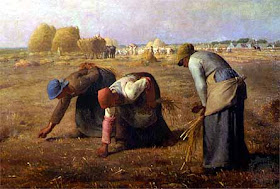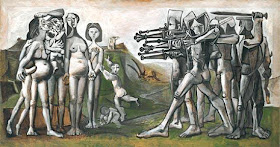
http://maiasintothemoonlight.blogspot.com.es/2009/06/sorolla-1863-1923-boys-on-beach-joaquin.html
Mother and daughter (Madre e hija)
Children on the Beach is a painting made by Joaquín Sorolla. Sorolla was born in Valencia on the 27th February 1863. Sorolla is a Spanish painter who excelled in the painting of portraits, landscapes and monumental works of social and historical themes. His most typical works are characterized by a dexterous representation of the peoples and landscape under the sunlight of his native land. He started his artistic learning in 1877 with the sculptor Cayetano Capuz in the “Escuela Superior de Bellas Artes” in San Carlos. He was interested in the open-air painting since he was young. He tried to capture the Mediterranean brightness, both in the Valencian garden and on the beach, as the French impressionists did. He completed his education in Paris and Rome, and when he came back to Spain, in 1890, he settled down in Madrid, where he started a successful career. Among his favorite themes, Sorolla stands out for his dedication to the landscapes of the Eastern coast of Spain, always with human presence and a remarkable presence of the light. Sorolla died in Cercedilla (Madrid) in 1923.
Children on the Beach was made in 1910. Sorolla signed a contract to paint a series of paintings about life in Spain for the Hispanic Society of America and he made fourteen murals which would decorate the institution rooms. They are known as Visions of Spain. With this painting, made between 1913 and 1919, whose dimensions are 3m x 70m, he raised an indelible monument of Spain, although scenes of diverse Spanish and Portuguese provinces were represented. He spent almost the whole 1912 travelling around the country, doing sketches and works of landscapes and customs. The oil paintings painted in 1916 dedicated to children and women in the Valencian beaches stand out in this series. The free brush stroke and the light of his native land predominate in them.
Some examples are:
Mother and daughter (Madre e hija)
Valencian Fisherwoman (Pescadora valenciana)
Idyll on the sea (Idilio en el mar)
Analysis
The dimensions of the painting Children on the Beach are 118 x 185 cm and the technique Sorolla used is a loose brush-stroke and the use of light. It is an oil painting on canvas.
Sorolla donated it to the extinct National Museum of Modern Art on the 28th February 1919.This painting belongs to a series on works of the same topic painted by Sorolla on the Valencian coast over a period of twenty years. This painting is in El Prado Museum now.
It was exposed on the 1911 exhibition in the USA, with other paintings, such as Idyll on the sea, very similar. These works contributed to Sorolla’s success in the West side of the Atlantic. Sorolla kept this painting until he donated it to the National Museum of Modern Art in 1919.
The happy images of the children enjoying on the Mediterranean beach and the heat of the Sun were loved everywhere. In addition, they allowed Sorolla´s extraordinary talent to be known among the American painters of this period. With loose brush-strokes full of bright colours, freedom and energy and an incomparable spontaneity, Sorolla seems to move the Sun effects shaking against the wet skin of the children. Representing the life on the sunny beaches that he loved, Sorolla captured the fleeting impressions caused by the Sun. Nevertheless, he admitted with sadness that he couldn’t paint the qualities of the Sun exactly as they are, only in an approximate form.
Idyll on the sea (Idilio en el mar)
The painting represents a crystalline beach with three boys there. The children are completely naked because they swam this way in the past. They are lying face down on the mud while the water touches their skin. They are in different positions:
One of them, blond and with pale skin, looks younger than the other ones and he is leaning on his elbow looking to the other boys, dark-haired and dark-skinned, whose bodies are lying in another position. The boy who is in the middle, is looking to the first one with a big smile while the other one is indifferent to the scene.
The blond boy is less sunken on the sand than the other two, and his body is outlined with more detail. His soles, the fingers of his feet, the muscles of his legs, his gluteus and back have more definition than the other children, who are half-buried on the wet sand. Their bodies are dimmer.
Children on the Beach is a good proof of the Sorolla’s skill to capture, with quick brush-strokes, the subtle colors of the swell. Also, with his amazing skill, he fixed the shadows under the children, just like the naked bodies reflected on the water and, with blue touches, the sparkles of the sky on the sand around. White brush-strokes –although for Sorolla total white didn’t exist, neither on the nature nor in the painting- capture the effect of sunlight rays with the wet skin.
Sorolla always looked for transmitting the effects of sunlight in his paintings and he managed to do it with the amazing ease we can admire in Children on the Beach. He was considered to be impressionist or post-impressionist. However, he refused to be called this way. Although he painted the moment, and he seemed to be close to the impressionism in his notes, he kept a realism that made up a very personal style.
Sorolla has a lot of paintings related with the beach. Here you have some of them:
The Horse’s Bath. (I really love this painting)
The Two Sisters.
Girl Going into the Sea.
The Sloop.
Sewing the Sail.
Walk on the Beach.
The Fisherman
Girls on the Sea
All these paintings are from the same website: http://www.todocuadros.com/sorolla/
As you can see, Sorolla reflected the beaches of his native land in his paintings. In many of them children appear, representing the happiness of the summer with bright colours. The sea had a big importance for Sorolla. In his paintings fishers, swimmers and boats appear. The sea reflects penetrate in them with a great luminosity.
The sunrays produced for him an iridescence that he expected and managed to fix on the canvas, as Monet in the consecutive versions of the Rouen Cathedral.
Sorolla said: "It would be impossible for me to paint in the open-air slowly. There is nothing unmoving around us. But even if everything was petrified and fixed, the movement of the Sun, what it constantly does, would be enough to give a different aspect to things". (“ Me sería imposible pintar despacio al aire libre. No hay nada inmóvil en lo que nos rodea. Pero aunque todo estuviera petrificado y fijo, bastaría que se moviera el sol, lo que hace de continuo, para dar diverso aspecto a las cosas”).
Similar Sorolla’s paintings to the painting I’ve chosen:
Children on the Sea. (Valencia)
On the Sand.
The Wounded Foot.
On the Beach.
The images are from the same website: http://www.gentearte.com/obras/Joaquin-Sorolla-Bastida/Ninos%20en%20la%20Playa%20Valencia.jpg/
CURIOSITIES
On the 8th November 2012, eleven paintings of private collections and other three coming from El Prado Museum, Lladró Museum and IVAM respectively, were incorporated to the second extension of Joaquín Sorolla´s Room of the San Pío V Museum of Valencia. Seven of them were unknown, they had never been exposed nor photographed.
Among the incorporated paintings is one of the twenty self-portraits he painted during his life, in 1915 dedicated to his son- in- law, Francisco Pons Arnau.
The unprecedented portrait of María Sorolla, his daughter, titled María with red top (María con blusa roja)
http://www.informavalencia.com/noticias/ampliar/1432/el-san-pio-v-contara-con-un-nuevo-sorolla
The child Jaime García Banús (El niño Jaime García Banús). (Children portraits that reflect the freshness and affection that Sorolla applied to these paintings).
Sorolla adopted the models of Velázquez as his own, playing with the references of some famous paintings and using the sources of the Sevillian painter in a direct form.
The provocative Nude Woman (Desnudo de mujer)- in which Sorolla honored in secret privacy the naked body of his wife-, recalls Velázquez’s Venus in her Mirror, while for the familiar portraits he was inspired directly in The Meninas.
Guys of La Mancha (Tipos de la Mancha). Maybe the background is our town !!!
http://www.foroxerbar.com/viewtopic.php?t=3993
PERSONAL OPINION
Raquel Ortiz Escribano 4ºA
PERSONAL OPINION
I’ve chosen Children on the Beach because I loved it the first time I saw it. I think it is a very beautiful painting that reflects the beach and the summer. It is simple in the sense that there aren’t a lot of people in it, because I don’t like that type of paintings. This painting makes me feel the innocence of the children who enjoy on the beach without worries and it transmits me calm too.
Sources:
http://es.wikipedia.org/wiki/Ni%C3%B1os_en_la_playa
http://www.museodelprado.es/enciclopedia/enciclopedia-on-line/voz/ninos-en-la-playa-sorolla/
http://www.xn--espaaescultura-tnb.es/es/artistas_creadores/joaquin_sorolla.html
http://www.epdlp.com/pintor.php?id=376
http://html.rincondelvago.com/joaquin-sorolla.html
http://es.wikipedia.org/wiki/Joaqu%C3%ADn_Sorolla
http://www.wordreference.com/
http://www.elmundo.es/accesible/elmundo/2012/11/08/valencia/1352407675.html
http://www.museodelprado.es/exposiciones/info/en-el-museo/joaquin-sorolla-1863-1923/la-exposicion/secciones/iv/
http://www.levante-emv.com/cultura/2012/11/08/inedito-sorolla-san-pio-v/950299.html
http://es.wikipedia.org/wiki/Ni%C3%B1os_en_la_playa
http://www.museodelprado.es/enciclopedia/enciclopedia-on-line/voz/ninos-en-la-playa-sorolla/
http://www.xn--espaaescultura-tnb.es/es/artistas_creadores/joaquin_sorolla.html
http://www.epdlp.com/pintor.php?id=376
http://html.rincondelvago.com/joaquin-sorolla.html
http://es.wikipedia.org/wiki/Joaqu%C3%ADn_Sorolla
http://www.wordreference.com/
http://www.elmundo.es/accesible/elmundo/2012/11/08/valencia/1352407675.html
http://www.museodelprado.es/exposiciones/info/en-el-museo/joaquin-sorolla-1863-1923/la-exposicion/secciones/iv/
http://www.levante-emv.com/cultura/2012/11/08/inedito-sorolla-san-pio-v/950299.html
Raquel Ortiz Escribano 4ºA














+parecido.jpg)





















.jpg)











